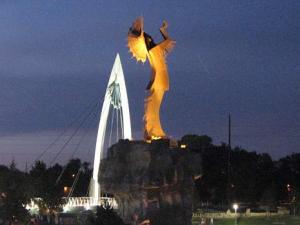If we are searching for God in the present, perhaps a good place to look is the fiery center of our rage?
This weekend, I came across an article from the Houston Chronicle detailing rampant sexual abuse within some churches in the Southern Baptist Convention (SBC).
 The stories detailed in the article are heartbreaking. Many of the accused (and some convicted) church leaders are still serving in church leadership. They’re in positions where they have both access to men and women and a position of “sacred” authority. These two elements are key in creating authoritarian forms of abuse in the church.
The stories detailed in the article are heartbreaking. Many of the accused (and some convicted) church leaders are still serving in church leadership. They’re in positions where they have both access to men and women and a position of “sacred” authority. These two elements are key in creating authoritarian forms of abuse in the church.
One particular account in the article flayed my spirit open. It was the story of a young woman who committed suicide. After she revealed that she was sexually abused by a church leader, her accusations were not taken seriously. Church leaders and representatives simply ignored her.
If we want to find God’s presence, perhaps we should look at the fiery center of our rage?
When Rage Asks Questions
The recent responses from SBC leadership is heartening, though many have rightly asked the question, “Why now? Why did it take this article to prompt action?” The reason the question matters is because a motion was placed before the SBC in 2008 to provide greater awareness and oversight of the independent SBC churches in regard to abuse claims.
Mainly because the claims were emerging en masse in 2008.
But the 2008 reforms were roundly rejected. They were rejected by individuals who are still in positions of leadership in the SBC.
Since then, stories of victims have continued to emerge. Not victims who experienced trauma, betrayal, and abuse prior to 2008 but those who have experienced it after 2008. In other words, people who would have benefited from the reforms of 2008.
If we want to find where God is working and active, perhaps we should look at the fiery center of our rage?
Never Read the Comments
The comments on the articles & social media posts regarding this story broke my heart further. The adage “never read the comments” again proves its wisdom.
There is one thread I found in the comments that needs to be addressed, however. I frequently saw comments I would summarize with the phrase, “This is an issue of the Gospel, period, not policy.” I understand the sentiment, I suppose. Dealing with individual sin and brokenness – what I call “non-life” – is definitely a piece of the Gospel.
A piece.
There is a bigger picture of the Gospel, however. It is a picture of the Gospel painted by black theologians like James Cone who see that Jesus’ work does not happen without liberation for the oppressed and marginalized.
Which means you have to deal with the systems that create oppression and marginalization, as well as the singular actors.
The picture emerges that yes, the abusers’ brokenness is an issue. However, the brokenness of church leaders who hear accusations and turn aside must also be placed under the incisive grip of the Gospel.
Personal repentance is critical.
Corporate repentance is as well.
Sometimes it’s a view of God that creates these broken places. Theology within the church that minimizes the predominant – read “mainly female” – voices of the victims is inconsistent with the Kingdom ethic of Jesus.
If we cannot listen, we cannot repent: whether as a person or as a people.
Without finding God in our rage, we won’t know to what we’re supposed to listen.
When Rage Comes Home
These thoughts roll in my head as I read. Pictures of my daughter flash in my mind, taken at the ages of the victims in the article. I think about the deep and irreversible physical damage, the emotional consequences, and the relational challenges that come with early-stage sexual abuse.
The feeling I have when reading the SBC article is very simple: rage. Then the thought occurs to me:
If we want to find where God is working and active, perhaps we should look at the fiery center of our rage?
Today, I’m walking through this rage. I am looking for God’s wisdom in this rage. It can’t bed down, abate, or grow quiet. But the rage cannot overtake me, either.
Yet the balance is necessary to remind me that formation without the space for rage is formation that will never truly speak to injustice.
I want the rage to push me towards God and His Spirit. We all need Jesus’ ethic about enemies planted deeply in us through our rage. I pray the rage becomes healthy – a beautifully indignant posture.
I know this posture MUST happen because my un-sanctified rage has only “non-life” as an outcome. And still, I pray the rage remains.
We should never come to believe the details of this article are normal.
Stories like these must never lose their sting and their viciousness.
If we lose the ability to enter into the rage of seeing followers of Jesus, leaders, embrace the non-life away from God we will come undone.
Praying Through Rage
I invite you to pray, in whatever way you pray, for those broken by abuse and those who allow the brokenness to continue. Both people are afraid: the former is afraid of more shame and violation. The latter is afraid of losing the only life they understand and possibly the income that sustains their family.
Truly righteous rage searches for the unprotected in our midst. We shield the victims and the vulnerable with our voices, with our prayers.
Let our rage instead gracefully expose the privileged and protected, who stand behind historical and theological shields seeking another victim to groom and destroy.
Pray, in a sense, for the sustained rage to push against that which cannot be Christ. Then and only then will we find the kind of grace that renews, restores, and transforms.
(Photo by Aarón Blanco Tejedor on Unsplash)















